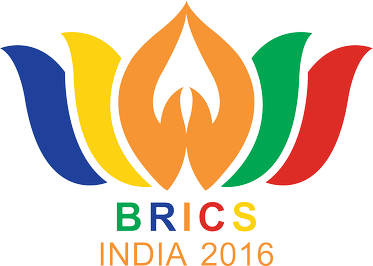8th BRICS SUMMIT, GOA, INDIA
Group of 5 powerful nations under the name of BRICS concluded their 8th summit in Goa, India. The summit was held form 15 to 16 October 2016 under the theme of "Building Responsive, Inclusive and Collective Solutions". Number of agreements were signed during the summit and the summit concluded with the adaptation of Goa declaration.
Goa declaration is a joint declaration accepted by all BRICS nations. It is a declaration of 20 pages comprises of 100 different matters over which all BRICS nations agreed. Some important points of the Goa declaration are -
i) BRICS nations condemns terrorism in all its forms and nation agreed to adopt CCIT which stands for Comprehensive Convection on International Terrorism. CCIT is a concept given by India in 1996. CCIT helps in setting up a legal framework for taking action against terrorism, no nations will be able to help terrorist organisations and nations sponsoring terrorism. BRICS nations has appealed to the world and UN for adopting the CCIT.
ii) Nations also agreed to increase their trade upto 500 billion dollars ie. almost 33 lakh 40 thousand crore .
iii) Nations welcomed the adoption of 2030 agenda for sustainable development and its sustainable development goals given during the UN summit on Sustainable Development
iv) Members are concerned about the situation in middle east and North Africa and supported all efforts carried out under international laws for finding the settlement of the crises.
v) Nations also supported for finding the solutions for disputes between Israel and Palestinian under the UNSC resolution, the Madrid Principles, Arab peace initiatives and previous agreements between the two nations.
vi) BRICS nations expressed deep concern over the security challenges in Afghanistan and supported the efforts of the Afghan lead counter terrorism operations.
vii) Nations ensured that by the help of National Development Bank the development projects of member nations get completed.
viii) Nations also supported the importance of taking strict action against terrorist organisations like ISIS and Jamat al Nusra.
INDIA'S SHOPPING-
During the BRICS summit Russia agreed to sell S 400 air defense system to India for 39 thousand crore Rupees.
Russia will also give 4 warships to India out of which two will be made in India under Make in India initiative.
Apart from these India is also purchasing 200 light utility helicopters from Russia worth rupees 6,680 crore, 60 helicopters will be send directly from Russia and the remaining will be made in India by the help of Russia.
Things that are not added in the declaration-
- The declaration didn't talk about the terroist groups like Jes e Mohammad and Lashkar e Taiba.
- The declaration supports the peaceful way of finding the solution of Israel and Palestine but Kashmir and Balochistaan issue is also not covered in the declaration.
- No view over the Pakistan occupied Kashmir,
- Crises in middle east and north Africa is mentioned in the declaration but the terrorism and violation of cease fires across LoC is not mentioned








